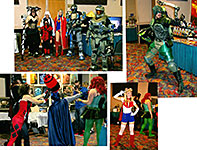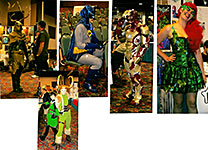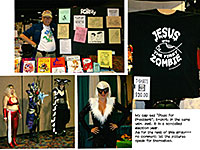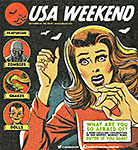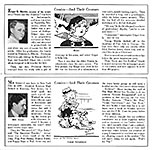 |
||||
Opus 331 (October 31, 2014). Like the butcher who accidentally backed into the meat slicer, we’ve got a little behind in our work here at Rancid Raves, but to make up for it, we’ve got a whopper on the burner for the first week in November. Until then, here’s a place-holder with some of the best news of the last month. Here’s what’s here, in order—:
NOUS R US New York Comic Con Portents for Future Comic-cons Rocky Mountain Con Costume Wearing at the NY Comic Con Moscow’s First Comic-Con EC Horror on USA Today’s Weekend School Censorship Fails Tantalizing Tidbits
Cartoons Oppressed in Turky and Venezula
Dave Gibbons: Comics Laureate NCS Revamps Awards Process Girls Getting Into Comics Shuster, Kirby, and Stan Lee Media—Still in Court DC Moving to Burbank
Under the Spreading Punditry Politics and Other Strange Happenings
Our Motto: It takes all kinds. Live and let live. Wear glasses if you need ’em. But it’s hard to live by this axiom in the Age of Tea Baggers, so we’ve added another motto:.
Seven days without comics makes one weak. (You can’t have too many mottos.)
And our customary reminder: don’t forget to activate the “Bathroom Button” by clicking on the “print friendly version” so you can print off a copy of just this installment for reading later, at your leisure while enthroned. Without further adieu, then, here we go—:
NOUS R US Some of All the News That Gives Us Fits
THE BIG NEWS OF THE MONTH for comics fandom is that the New York Comic Con, held this year October 9-12, knocked the San Diego Comic Con International off its throne as the biggest comic-con in the country (perhaps in the world). Big news but not much of a surprise: New York is the most populous of our nation’s cities, so events staged there should be attended by the largest crowds. But it’s taken a few decades of limping listlessly for the Big Apple to finally get around to putting on a funnybook show worthy of the city’s size and influence. Even Entertainment Weekly has taken notice, running a short article about the NY Comic Con in a recent issue. Look for longer pieces in the future: the magazine’s editorial office is, conveniently, in the City. New York registered, it is reported, slightly over 151,000 geeks, nerds, and other happy personages; Sandy Eggo, limited by the size of its venue—the San Diego Convention Center and the city’s fire marshal, who cuts off attendance when it exceeds what he deems a safe number for the facility—has been registering 125-130,000 for the past decade or so. It could be bigger, we suppose—and Sandy Eggo factotums are likely to claim—if the fire marshal were a less risk averse official. Not that we’d like that either: we’re all for safety. While New York’s roaring success ought to be gratifying to funnybook fans everywhere, it actually isn’t. Comic-cons, New York’s included, are no longer events for those who dote on comic books. Sandy Eggo long ago became what its organizers call “a popular culture festival”—movies, games, toys and other cultural detritus that may have originated in the four-color fantasies of comic books but now eddies in ever-widening circles throughout our culture, from books and magazines to television, from stuffed dolls to the big screen. And vice versa. Hollywood, as many have observed (sometimes cynically), invaded Sandy Eggo years ago and imparted to the annual shenanigans a distinctly tinsel-town gleam. As comic book superheroes have taken command of the nation’s movie theaters, so have they influenced the once humble comic-con. Movies not comic books are the medium. Actors not cartoonists are the celebrities. And superheroes in colorful costumes are the enviable icons. At New York, the center of gravity shifted a little. Guests from the realms of comic books exceeded those from the entertainment universe: the NYCC website lists nearly 350 comic book artists and writers vs. about 250 actors and screen writers. The comic book industry brought in Bob Layton and Geof Darrow, Gerry Conway and Gail Simone and Michelle Delecki, Joe Staton, and Sean Murphy, Adam Hughes and Amy Reeder, Chris Claremont and Garth Ennis, Neal Adams and Todd McFarland, Howie Chaykin and Humberto Ramos, Al Milgrom and Matt Fraction to name a few by way of illustrating the scope of the guest list. From movies and tv (mostly television)—Amy Sedaris and Chad L. Coleman, Daniel Portman and Lucy Liu, Ron Rerlman and Jerry Springer (Jerry Springer? the tv religion pitchman?), again, just naming a few. While the roster of comic book creators is long—longer, I suspect, than a similar list in San Diego—we must remember that New York is a publishing mecca for comic books, and the chances are that finding nearby comic book creators who’re willing to guest at the Comic Con isn’t difficult; by the same token, finding movie stars on the West Coast near Hollywood probably isn’t as hard as finding comic book creators out there. Still, the New York Comic Con apparently didn’t want too many cartoonists. No New Yorker cartoonists (who almost all live near the City) were guests; and apart from Staton, who now does Dick Tracy but started out in comic books, no syndicated comic strip cartoonists, many of whom live near New York, were among the guests listed at the Con’s website. A fascinating footnote: the NYCC website lists celebrities who cancelled. Stan Lee among them. Perhaps this maneuver, if more widely adopted, might discourage frivolous cancellations. (Or frivolous acceptance of invitations by would-be dignitaries who fully expect to cancel later if something better comes along.) Whether these developments are good or bad only the future can tell. Based upon simple demographics alone, we may see Sandy Eggo tilt more and more into the movie and tv realm with New York emerging as the better site for comic book fans. Some among us have been busy trying to anticipate the future.
HOLLYWOOD STUDIOS, EAGER to capitalize on the popularity of superhero movies, have planned comic-book based productions well into the rest of this decade. “Studios have already slated 22 titles over the next five years,” saith Stephanie Merry at the Washington Post. “Warner Bros plans to produce 10 DC Comics movies between 2016 and 2020.” If all goes according to plan, we’ll have superhero blockbusters every summer for the foreseeable future—dozens of them. But a few timorous souls have begun to wonder how long all this giganticism is going to last. In October 10's Entertainment Weekly, senior writer Darren Franich says he has “Batman fatigue.” Taking the Caped Crusader as his benchmark, Franich writes: “Two years after the final film in Christopher Nolan’s Dark Knight trifecta, Bruce Wayne’s alter ego is everywhere. In video-games, there’s Batman: Arkham Knight. In comic books, DC has eight series with the word Batman in the title, and that doesn’t include spin-offs like Batwoman and Batwing.” Writing ostensibly about tv’s “Gotham,” Franich says: “The ‘Gotham’ premiere felt almost like a dare. If you make a Batman tv show without Batman, will people show up? They did. Eight million of them. So have we reached Peak Batman?” And if we have, what’s next? And Franich is not alone in fearfully contemplating a future movie landscape without superhero summer blockbusters. Nothing lasts forever, they all say. And that means superhero blockbusters will someday flop at the box office. And when they do (not if but when), Hollywood will move on to the Next Big Thing. And then what will become of the comic-con industry? Without costumed celebrities to pump up attendance, what is left? Probably not comic books. At least, not just comic books. One of the original purposes of comic-cons was to provide a marketplace for the selling and collecting of vintage Golden Age comic books. Most of those have, by now, been sold and collected. They’re now mostly in the hands of private collectors and a few museums or libraries. So what’s left? I’m happy to report that we’ve already seen the future.
THE WEEKEND OF OCTOBER 24, my wife Linda and I attended the Rocky Mountain Con in a hotel on the northeastern outskirts of Denver, near the airport (as are scores of other hotels, all capitalizing on convenient location for hosting conventions of traveling businessmen/women). Linda doesn’t go to comic-cons. She’s not a fan of cartooning; doesn’t even read the funnies in the newspaper. But she came along, thinking that at my advanced years, I need all the physical help I can get lugging boxes of books and art prints to my table in Artists Alley. And I was glad for the help. And the company. The Rocky Mountain Con (notice, significantly, that it’s eliminated the word “comic” from its title) is a sort of extended artists alley. Displays were split about evenly between artist alley tables and booths, but those in the booths offered pretty much what those at tables offered. Same stuff, a little more display space. You could buy comic books, mostly Silver Age and later, at only 2-3 booths. Not a big presence. On display on tables and in booths—some original art for sale, prints, posters, toys, games, plush dolls, action figures galore, knick-knacks, even jewelry. Linda, who came Sunday even after experiencing the ennui of sitting at a table all day Saturday—because she enjoyed being where there were people, she said—nailed the nature of the con: “This is a craft show,” she said. And she’s dead right. Some of the crafts had nothing to do with comics, movies or television. Jewelry, f’instance. Plush dolls. Pinups with cleavage at both ends. Most of the cartoonists were web cartoonists, unpublished in print anywhere except self-published booklets and magazines. Some were good. Many were not so good. But they were all earnestly trying to make a buck from whatever skill they had. And they were having fun. Which reminds me of the classic response an experienced cartoonist should make to a young aspiring cartoonist when the work he’s shown is terribly amateur stuff: “Do you enjoy doing this?” And the answer is always, “Yes.” Then you say: “Well, you should keep on doing it then.” Noncommittal. Encouraging without being critical. Don’t kill the kid with penetrating criticism that reveals only how lousy his work is. Having fun. And the Rocky Mountain Con was certainly fun. I wouldn’t do it for the revenue it brought me. But for the fun of it, surely. No big-time celebrities were under spotlights at the Rocky Mountain Con. A half-dozen lesser lights, including Ron Fortier and Mike Baron, f’instance. Otherwise, cosplay all over. The Rocky Mountain Con was chiefly a parade ground for costume enthusiasts. And some of the costumes were beautifully, intricately made. Some were not. Green Arrow requires more of a costumer than one of the walking dead, whose clothes are tatters and not much more.
Like most other comic-cons (few of which are honest enough to delete “comic” from their names), cosplay has taken over. It’s been a-borning for decades. The first comic-cons had costume parades. Then costume contests. And as movies became better at portraying superheroics and subsequently invaded the premises of comic-cons with the movie stars who acted out the comic book fantasies, wearing the costume of your favorite superhero became de rigueur for a large contingent of comic book fans. In costume, they were, in effect, acting out their favorite fantasies—just as they saw the movie stars doing. But part of the motivation was something a little different. Linda, watching the procession of costumed personages, wondered what possessed them to want to do this. Some of the cosplayers spent the entire day, wandering around the aisles of the show—never buying anything. Just wandering and being looked at—and photographed. Being photographed is a big part of cosplaying. The minute a cosplayer realizes someone is aiming a camera at him/her, he/she strikes a pose. The photographer takes his shot, politely saying “Thanks” when finished. Linda finally decided what prompted the display. “They want to be celebrities,” she said. And I think she’s right. Dressing up like their favorite comic book characters, cosplayers become those characters, and, consequently, they become also the celebrities that those characters have become—in funnybooks, of course, but, more significantly, on tv and on the big silver screen. (More about this from a somewhat different but valid point of view in Will C. Franklin’s essay below.) Some
of us, though, wear nondescript but nonetheless (we hope) picturesque attire.
Not costumes exactly. In my case, more like a cartoonist fan uniform: t-shirt
with cartoon character on it (Pogo and Albert running for office); baseball cap
(Pogo for President). Well, it’s an Election Year. Rocky Mountain Con came into being with an altruistic motive: a portion of its proceeds goes to Aurora Rise, which tries to make “a little bit brighter” the days ahead for those affected by the midnight massacre at an Aurora movie theater on July 20, 2014. “We will continue this effort so that no one will ever be forgotten and so that the public will never forget.” —AuroraRise.org But in other respects, Rocky Mountain Con is a harbinger for the future of comic-cons. They are all slowly devolving into craft shows and costume parades. That’s the future, kimo sabe. Cons will attract more and more cosplayers, not comic book fans. Comic book fans are likely to come only to the big cons, the ones with big-time publishers (DC, Marvel, Dark Horse) in the exhibit hall. (Hence, the future success of the New York Comic Con held in the city where more comic book publishers reside than anywhere else.) Already, many comic book stores of my acquaintance don’t see comic-cons as sales opportunities. My comic book shop doesn’t take high-end comics to the con: those who attend cons are not comic book collectors and aren’t looking to complete their collection of Donald Duck comics by Carl Barks or Boys Ranch by Simon and Kirby. The customers will buy current (or nearly current) comic books, but not Golden Age. And sometimes, graphic novels but not comic books. We should welcome the future comic-con for what it is. Or, perhaps—as Will Franklin suggests just below—for what it aspires to be, rather than what it is.
COSTUME-WEARING AT THE NEW YORK COMIC CON By Will C. Franklin at Maryland Community’s online Gazette.net Excerpt OUTSIDE OF NEW YORK CITY’S JAVITS CENTER, people walking by looked at those in costume with something more than curiosity. It almost felt like disdain, maybe pity. Why, they seemed to wonder, would you dress up as a comic book character in skin tight outfits and make a fool out of yourself in public? Inside, that wasn't the case. People would stop and take pictures of those in costume. The costumed folks would always stop and pose while the photographer would snap pictures and say, “Thanks.” It was the same no matter what corner of the Javits Center I went to — very polite people on both ends of the spectrum. And, like a barrel full of kryptonite, it hit me. There were no skinny Supermen. There were no fat Wonder Women. No black Robins or Batmen, no Asian Korras and no Hispanic Green Arrows. No disabled Deadpools, either. Just Supermen, Wonder Women, Batmen and Robins, Korras, Green Arrows and Deadpools. Once inside the safety of the building, everyone was the same. No black or white. No thin or fat. No healthy or disabled. No gay or straight. Take a moment to think about that. With the conflicts and discrimination that always threaten to drive a wedge into our society, would you believe there was one place where people of all shapes, sizes, colors and creeds were accepted and celebrated? Would you believe that place would be a comic book convention? For years, people have looked down on those who are into comic books and the like. The stereotype is there: Single guys who live in their parents' basement and spend all day at the comic book store, when they're not in front of a computer. Chances are, you probably have the mental image of the Comic Book Guy from the television cartoon “The Simpsons” in your head right now. Of course, that's not always the case, considering I spoke [during the NYCC] with several people [in attendance] who had high-paying jobs in the medical, education and information technology fields. Why, then, is society so unwilling to accept a culture of folks who are so accepting of others? Perhaps it goes back to the fear of the unknown? People fear what they don't understand. Maybe they're afraid they'll look foolish? All I know is the people who attended New York Comic Con looked happy because they were happy. Maybe we should take a chapter out of the “geek” playbook and become more accepting of not only others, but ourselves? Maybe we should all start dressing up as our favorite superheroes more often. I'll be Batman and accept folks for who they are, not what they look like.
FITNOOT: I’m not sure Franklin means what he appears to say in that last sentence because the cosplayers he’s talking about are people who’ve made themselves look like someone they are manifestly not. Moreover, racism is based upon the mindlessly myopic notion that people are what they look like: it’s the black man’s skin that gets him badly treated, not what he is. Perhaps a better concluding line—one to which all Franklin has said seems to be leading—is: I’ll be Batman and accept folks for who they want to be, for their idealisms and hopes.
AND THAT’S NOT ALL— Even in Putin’s Russia. The MoscowTimes.com reports that “thousands of comic-book, video-game and science-fiction enthusiasts swarmed Moscow's Crocus Expo center over an October weekend for Russia's first-ever Comic-Con, an international convention aimed at fantasy lovers.” Predictably, many attendees came dressed as their favorite comic book or movie characters. And— George R.R. Martin, author of Song of Ice and Fire upon which HBO’s “Game of Thrones” is based, claims to be the first comic book fan. And he’s almost right. The program booklet for the alleged first comic-con—in New York in 1964—lists registered participants, and Martin is Number One. Unhappily for Martin, the New York event that summer was not the first comic-con: the first was held in April of that year in Detroit. But Martin doubtless doesn’t know that. All of which proves—if it needs proving—that if you want the Immutable Truth As We Know It, come hither to Rancid Raves.
A VICTORY FOR ADULTS BEHAVING LIKE GROWN-UPS From Brigid Alverson at blogs.slj.com: What is it about Persepolis? Marjane Satrapi’s graphic memoir of growing up in post-Revolutionary Iran has been pulled from classrooms in the Chicago Public Schools (but retained in their libraries) and challenged in Murphy, Oregon, and now a parent asked that it be removed from the reading list of Glenwood High School in Illinois. The parent objected to the book’s depictions of torture and a dismembered body, and he also questioned why the teacher would assign a book about Muslims on September 11. In a hearing before the Ball-Chatham School Board, Glenwood High School principal Jim Lee stood up for the book, saying, “Reading controversial material does not hurt students or corrupt them. … This is the world our students live in, and our students need to understand the reality of it.” The board voted unanimously to keep the book on the reading list. Bravo.
TANTALIZING TIDBITS ■ James Hibberd’s “Fall TV Face-off” in October 17's Entertainment Weekly says: “Fox’s ‘Family Guy’ posted its biggest ratings in four years due to its ‘Simpsons’ crossover.” ■ Alerted by the latest issue of Previews, the comic book catalogue from Diamond, I know now that I can purchase a Buddy Christ plush doll. Yes, the “Spokesdiety Buddy Christ is now a super-cuddly 8-inch tall doll with finely stitched details” just awaiting your conversion—er, purchase. ■ Gary Groth is the 2014 Stranger Genius Award winner in Literature. The Stranger is a Seattle alternate newspaper; Groth’s Fantagraphics resides in Seattle, in what was once a two-story residence on Lake City Way NE. And I’ve written for (and been paid by) Fantagraphics for nearly 40 years. ■ “Somewhere between the rise of cable tv and the ubiquitousness of video games today, American kids fell out of love with Saturday morning animated cartoons,” reports wtop.com. Used to be cartoons dominated tv programming on weekday afternoons and Saturday mornings. “Today [on the Web], there’s programming 24 hours a day,” said Robert Thompson at the Center for Televison and Popular Culture at Syracuse University. “With the announcement that the CW will swap its Saturday morning children's line-up for a mix of programming aimed at teens and their parents, there will be no more dedicated children's programming on any broadcast network on Saturdays, according to ToonZone.net.” ■ Alison Bechdel, author of the critically acclaimed graphic novel Fun Home, said in a HuffPost interview October 3 that Art Spiegelman’s Holocaust-centric Maus set her free to take on serious subjects in what has always been a less than serious medium—comic books. "Comics were once sort of [for] superhero action stories," she recalled. "That was pretty much all they did, and [then] people started pushing the boundaries. Underground cartoonists in the '70s started writing about more adult topics and themes." She specifically credited "the more artistic cartoonists of the '80s" as well as Spiegelman as having "completely changed the medium" of graphic novels. "Spiegelman's Maus changed comics forever," she said. "Comics now can be about anything—any topics that's as serious as you can come up with." ■ New Yorker cartoonist Roz Chast admitted to Michael Cavna at the Washinton Post’s ComicRiffs blog that it’s been “exciting” to be the first cartoonist to be a nonfiction finalist for the National Book Award.
CARTOONS OPPRESSED IN TURKEY AND VENEZULA From todayszaman.com: Turkish prosecutors have filed an indictment against cartoonist Musa Kart at the Cumhuriyet daily over a caricature he drew criticizing then-Prime Minister Recep Tayyip Erdoğan's attempts to cover up a graft probe that shook the country late last year, seeking up to nine years and 10 months in prison for the cartoonist. ... In the cartoon that led to his trial, Kart depicted two thieves stealing money from a safe box. One of the thieves is saying “Don't rush, our watchman is a hologram” and Erdoğan can be seen keeping watch as a hologram in the background. Kart was referencing Erdoğan's appearance at a party meeting as a 10-foot-tall hologram in late January. “It once again becomes clear that there is caricature of justice in Turkey, not justice itself,” Kart said while commenting on his trial. The court began hearing the case on October 23; no news yet on the outcome. From the
New York Times and the Cartoonists Rights Network International: CRNI recently learned that Venezuelan
cartoonist Rayma Suprani has been fired from her job at El Universal because
of a cartoon critical of the national healthcare system. The cartoon included a
signature of former President Hugo Chavez flat-lining on an electrocardiograph
as a way to depict the country’s national health care system. Crap, Suprani explained. Or, more gently (not to say accurately): “My immediate boss called me and told me he didn’t like my caricature and I was out,” she told local radio. “We’ve become a country where if you say things, have your own criteria and try to provoke reflection, it’s not well-viewed.” Rayma has been in trouble with authorities in the past for other cartoons that have irritated the Venezuelan president, who seems to have serious allergic reactions to any kind of criticism from the media. For more details on Rayma Suprani's work and CRNI's intervew with Rayma, visit cartonistrights.org.
COMICS LAUREATE IN ENGLAND On the Internet: Bestselling graphic novelist Dave Gibbons is to become Britain’s first Comics Laureate. The announcement was made at the Lakes International Comic Art Festival on 17th October. The role of Comics Laureate is to be appointed biennially to a distinguished comics writer or artist in recognition of their outstanding achievement in the field. Their role is to champion children’s literacy through school visits, training events for school staff and education conferences. Dave Gibbons has won universal praise for his comics and graphic novel work for Marvel and DC Comics including the ground-breaking Watchmen (with Alan Moore), as well as the UK’s own 2000AD and Doctor Who. “It’s a great honour for me to be nominated as the first Comics Laureate,” Gibbons said. “I intend to do all that I can to promote the acceptance of comics in schools. It’s vitally important not only for the pupils but for the industry too.” He takes up his two-year position from February 2015.
NCS REVAMPS ITS AWARDS PROCESS Lately, it has been relatively easy to criticize the National Cartoonists Society for the way it gives out awards. It hands out trophies in 14 different divisions of cartooning, everything from newspaper comic strips to feature film animation to online short form comics. And over the last decade or so, cartooning has become a more and more complex skill as technology has permitted new kinds of cartooning to crop up in different ways. Clearly, there are different kinds of expertise in each division. And yet until the present revamping, the finalists and winners in each division were selected by NCS chapters. Even if everyone in a chapter attended the jurying for the assigned division, the winners were still determined by a relatively small number of members—some of whom might not even be aware of the special skills exercised in a given area of cartooning. Starting with the next nominating process—for the winners to be announced at the annual Reubens Weekend in May 2015—the voting will be open to all members of the Society for most divisions. Deploying online technology, members will vote to nominate finalists in Newspaper Comic Strips, Newspaper Panel Cartoons, Editorial Cartoons, and the Reuben itself (“cartoonist of the year”). A specialty jury will assemble nominees in Gag Cartooning, Newspaper Illustration, Greeting Cards, Magazine/Magazine Feature, Advertising/Product Illustration, Online Comics (short form) and Online Comics (long form). The winners in all these divisions will be determined by a membership-wide vote. Members will be able to see the work of all nominees in all divisions, each of which will have its own web page. Specialty juries will determine winners in Feature Animation, Television Animation, Comic Books, and Graphic Novels. This new procedure, it is fondly hoped, will result in winners that represent the opinions of the entire NCS, as should be the case when the awards are “the face of the organization to the rest of the world.” I don’t know to what extent Tom Richmond, the current NCS prez, is responsible for this welcome change, but my guess is that he’s been the driving force—and so deserves the thanks of all members of NCS and all fans of cartooning in its many manifestations. Big THANQUES, Tom.
GIRLS GETTING INTO COMICS From Heidi MacDonald and Calvin Reid at publishersweekly.com: There’s a new comics reader in town, and she’s a girl and a more casual customer, drawn to specific stories, rather than long-running superhero franchises. That was the overwhelming theme of the ICv2 Conference, “Understanding The New Comics Customer,” held the Wednesday prior to New York Comic Con. The conference offered data on the new comics customer, the explosive growth of comics festivals, retailer responses and a discussion of what this new customer is reading. ICv2 founder Milton Griepp kicked things off with his annual white paper on industry sales, recapping 2013 numbers which showed that comics are a $870 million industry including sales in comics shops, bookstores and digital. So far in 2014, graphic novel sales are up in “double digits,” periodical comics are up 3% and digital is “flat.”
COMICS IN COURT—STILL HollywoodReporter.com reports failure in the latest attempt by the estate of Superman co-creator Joe Shuster to reclaim a portion of the rights to the character and the millions he’s bringing in to DC Comics and Warner Bros. A 1992 agreement made by Jean Peavy, Shuster’s sister, forecloses on any such attempt—for now. In 1992 in the aftermath of Shuster’s death, his sister asked DC Comics to pay her brother's final debts and expenses. DC agreed and also increased survivor benefits, but the company's executive vp at the time, Paul Levitz, admonished: "This agreement would represent the author/heir's last and final deal with DC and would fully resolve any past, present or future claims against DC." As a result, as a federal judge ruled on October 6, "the broad and all-encompassing language of the 1992 Agreement unmistakably operates to supersede all prior grants." A few weeks before, reports Alison Frankel at reuters.com, the Kirby claimants came to grief. Slated to make a case before the Supreme Court, the plaintiffs instead settled—on undisclosed terms—thereby leaving in limbo for the nonce the legal rights of freelancers to work they did as “work for hire” before the new copyright law of 1976 took effect. The 1976 law redefined work for hire. “If you were employed by a newspaper or magazine, for example, the magazine owned the rights to articles you wrote under the 1909 law’s basic work-for-hire provision; if you were a freelancer who was assigned a story by a publisher, you were presumed to control the copyright.” But this proposition left undetermined the rights of freelancers who did work prior to the 1976 law. The void is being filled by the antique “instance and expense” test that came into being during the 1950s. Under this proviso, if a cartoonist is asked to perform work and is paid expenses, then the work belongs to the publisher who commissioned the work. A 2013 appeals court ruled that Jack Kirby was working at Marvel’s direction and expense, hence, the work was owned by the publisher. The case that was settled at the end of September might have taken another look at this situation. But that’s now moot. Not that the matter is resolved for ever and ever. The lawyer for the Kirby heirs, Marc Toberoff, says the issue of creators’ rights to reclaim their work after 56 years (two consecutive 28-year periods as specified in the 1976 law) will not go away. “This is precedent that needs to change,” he said. “There will be other cases. And, speaking of interminable, Stan Lee Media is still suing Disney for rights to the Marvel characters created, at least in part, by Stan Lee—rights Disney thought it was buying when it bought the Marvel stable. Forget that Stan Lee Media is an entity whose legitimacy has been in question for years—and is no longer associated with Stan Lee. Whoever’s speaking for Stan Lee Media wants a piece of the action. And has been filing law suits for years. In a picturesque locution, Disney attorney Jim Quinn referred to the action as “their seventh bite of a rotten apple. ... Plaintiff has tried time and again to claim ownership of those copyrights; the litigation history arising out of the 1998 agreement stretches over more than a decade and at least six courts. Plaintiffs cannot wait a decade to enforce their rights,” he concluded. But the law being the law, in all its convolutions, and legal fees being bread and butter to attorneys, the case is likely to linger on in its own Bleak House. In fact, as long as our court system has an appeals mechanism, these things are not likely to go away any time soon.
DC STAFF AND FREELANCERS REASSURED The publisher is moving West to take up residence in Burbank, nearer the center of all things celluloid, no doubt, in order to better coordinate film and print universes of superheroes. Seems a little short-sighted to me: as I mention elsewhere, the superhero blockbuster film can’t last forever. But DC is moving, and DC Entertainment Prez Diane Nelson wrote a letter to staffers and freelancers to reassure them. Among the paragraphs of her reassurance is this one: “The new structure is intended to drive greater collaboration and coordination across our various functional areas as they come together in a single location. This includes more closely connecting related business activities, ensuring clarity of roles and responsibilities, increased focus on content, franchise and business planning, as well as, more emphasis on Talent development & recruitment.” All the rest of the letter is pretty much the same sort of hogwash, mostly not so reassuring as Nelson hoped. “Talent development and recruitment” can be read to mean: artists and writers and editors who don’t make the move physically to California are likely to be replaced by “Talent” that lives closer to the Burbank offices. But that’s just the cynic in me.
Fascinating Footnit. For even more comics news, consult these four other sites: Mark Evanier’s povonline.com, Alan Gardner’s DailyCartoonist.com, Tom Spurgeon’s comicsreporter.com, and Michael Cavna at voices.washingtonpost.com./comic-riffs . For delving into the history of our beloved medium, you can’t go wrong by visiting Allan Holtz’s strippersguide.blogspot.com, where Allan regularly posts rare findings from his forays into the vast reaches of newspaper microfilm files hither and yon.
We’ll be back at this spot again soon—within a week, I ween, with more comics news and reviews than you can imagine. Below, we offer a preview of what’s pending. Don’t miss it if you can.
EDITOONERY The Mock in Democracy In this department next time, we’ll see what the nation’s editorial cartoonists have been saying about the Big Events of October (not the election, which is a little event), and we’ll take a quick look at what they say about who won (and lost) the Midterm Fiasco.
RANCID RAVES GALLERY Pictures Without Too Many Words & COLLECTORS’ CORNICHE In these two departments next time, we’ll explain these two pictures.
NEWSPAPER COMICS PAGE VIGIL The Bump and Grind of Daily Stripping Under this heading next time, we’ll look at some anniversaries and other, similarly historic, moments in comic strips over the last month—Mother Goose and Grimm, Hi and Lois, Luann, Freshly Squeezed and Dick Tracy.
BOOK REVIEWS Critiques & Crotchets Next time, reviews of: Marvel’s 75th Anniversary Magazine, Batman: A Celebration of 75 Years; What Fools These Mortals Be: The Story of Puck, America’s First and Most Influential Magazine of Color Political Cartoons; Ripley’s Believe It Or Not: Daily Cartoons 1929-1930; Walt Kelly’s Pogo: The Complete Dell Comics, Volume One; Walt Kelly: The Life and Art of the Creator of Pogo; and We Go Pogo: Walt Kelly, Politics and American Satire—and more, of course, much more.
ONWARD, THE SPREADING PUNDITRY The Thing of It Is ... ■ MORE THAN HALF the members of Congress have a net worth of $1 million or more; there are five millionaires on the Supreme Court and one in the White House. Think we’ll ever get legislation aimed at reducing the gap between the very rich and the rest of us?
■ DISNEY IS LOCKED in a legal battle with EDM artist deadmau5 over trademark infringement. The artist uses a mouse head logo, a big circle surmounted by two smaller circles—looking an awful lot like Mickey in silhouette.
■ FROM THE WEEK: In California, where 82 percent of the world’s almonds are produced, it takes a whopping 1.1 gallons of water to produce a single kernel; indeed, the water used by almond farmers could supply 75 percent of California’s population. But with global nut business booming, especially in China, almond farmers have continued to plant trees in spite of the drought—in the process, causing water to be diverted from the Kalamath River, threatening the salmon that feed the local Yurok tribe. “Not only are they asking the Native Americans to sacrifice their culture,” says Yurok member Frankie Myers, “but we’re doing it so we can sell almonds to the Chinese.”
■ YOU’D THINK, given the importance that the founders assigned to freedom of the press—a Constitutional amendment in order to guarantee free debate on matters of civic import—that the news media would be vitally interested in exposing political falsehood whenever and wherever it is found. Why, then, are so many political ads on tv permitted to run again and again, promulgating half-truths and (sometimes, yes) outright lies without a vigilant press correcting the misrepresentations so blatantly foisted off on a voting public? The answer is as simple as the self-interest of politicians everywhere. If a newspaper, say, were to investigate the assertions of one candidate in order to validate their accuracy, the newspaper would surely have to investigate the opposing candidate’s assertions, too. And the newspaper no doubt has a vested interest in getting one of the candidates elected. So rather than “attack” (verify the verisimilitude) of their favorite, they refrain from attacking his opponent, too. And both rant on, willy nilly, spewing lies and half-truths to a fare-thee-well.
■ In Jacksonville, Florida a couple weeks ago (you may not have noticed amid all the fuss attending the Ferguson debacle), a white man was sentenced to life without parole for shooting and killing Jordan Davis, an unarmed black teenager who was killed at a gas station because he and his friends were playing music too loud in their SUV for the ear-comfort of the man who, when the boys wouldn’t lower the volume, took the law into his own hands (as is the wont in Florida), pulled out a gun and fired 10 shots into the kids’ vehicle, striking Davis three times and killing him. The killer claimed he was acting in self-defense. Comeuppance.
To find out about Harv's books, click here. |
||||

send e-mail to R.C. Harvey Art of the Comic Book - Art of the Funnies - Accidental Ambassador Gordo - reviews - order form - Harv's Hindsights - main page |
